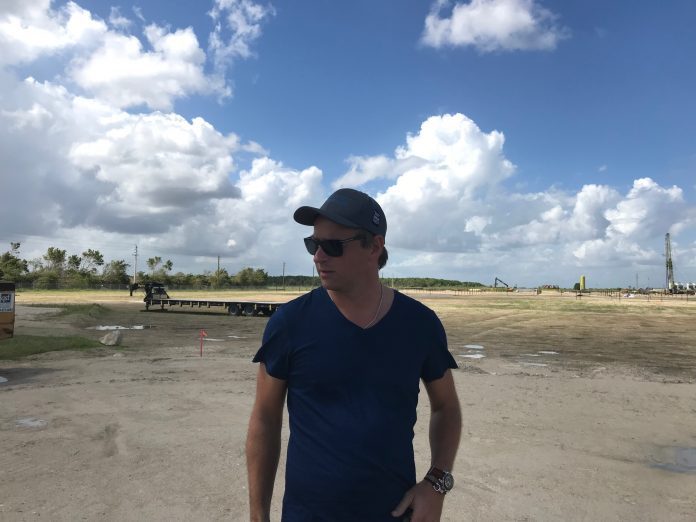Atlantic Sapphire goes large when it wants to produce salmon on land in the United States.
“Behind, we can find The Everglades. It’s really just one damn big swamp of crocodiles and anaconda. We have actually found alligators here on the site.”
Johan Andreassen lifts his Atlantic Sapphire hat and dries some beads of sweat from his forehead.
Far south
Homestead is a one-hour drive southwest from downtown Miami. It is an agricultural area bordering on dense jungle and swamp. On the fields along the roads are planted herbs, passion fruit, and salad leaves.

“We’re closer to the Florida Keys than Miami. If you look at the United States map, we will farm salmon as far south as it is possible to get on the US mainland. It is only 20-30 minutes to the southern tip of Florida.”
Dimensions
Behind him, we can see drilling towers. Here they do not drill for oil, but water.

Andreassen points them out and explains eagerly.
“The property is 80 acres. The drilling tower over there is an inlet well for saline water and goes 2,000 feet down. The well has a capacity of 3,000 gallons, 10-11 cubic meters per minute. These two blue pipes take in freshwater. They go 50 feet down. Fresh water should go to fry and smolt.”
“The injection well goes 3,000 feet down, about one kilometer, and it deposits used water. We have high emissions capacity – enough to farm 90,000 tonnes – almost 10 percent of Norway’s salmon production,” he points out.

The hydrogeological conditions in Florida are distinctive and offer rare opportunities for both innovative and potentially disruptive thinking.
Largest in the world
“The ground is pure limestone. So that means the water is hard. Florida is very special. It has been both above and under water in the past 10,000 years. It means that you have different layers. There are about 300 such plants (wells) in Florida. But this is the only place in the United States that has it this way. It is probably the largest groundwater level in the world,” he explains.
“In principle, we put in roe and take out fillets,” Andreassen tells SalmonBusiness.
He bends down and draws a simple plan of the site.

“Here we have a smolt plant, hatchery and grow-out,” he says, pointing eagerly
“The water temperature is completely stable. It stays at 25 degrees. We will run a heat exchanger and dump it into the ground. It’s like a reverse heat pump,” he continues.
“The water is completely reintroduced. Here there are no heavy metals, pathogens, PCBs, micro-plastic or lice. And it is under pressure. As you drill down, the water shoots ten meters in the air. That makes it easy for us.”
The groundwork is in full swing. Soon the equipment will arrive for intensive fish farming.
 “350 containers with equipment from Billund will be stored here. The next thing to happen will be fitting pipes. I think we’ll have laid the floor around March/April,” estimates Andreassen.
“350 containers with equipment from Billund will be stored here. The next thing to happen will be fitting pipes. I think we’ll have laid the floor around March/April,” estimates Andreassen.
Risk
The landscape is dead flat, and a good way inland.
“We are a mere 5.5 feet above sea level,” says Andreassen. “There’s a reason we’re running it here. But flooding is a greater risk than hurricanes. They do not hit that hard,” he says.
“We’re initially budgeting for 8,500 tonnes of gutted fish per year. Building stage two will take us up to 28,000 tonnes of gutted fish. After we have built everything we aim to produce 90,000 tonnes.
“The reason we are here is the water. There is nothing that comes out. No neighbors or landowners who complain. Fish escapes are impossible. It only costs 50,000 USD to drill a normal well. The one over there costs five million USD. The water is the blood of the plant.”
Atlantic Sapphire will spend $ 110 million on the first stage of building.
“Building stage two is only grow-out – both the smolt plant and hatcheries are built for greater production. Over the past year, we have amassed 82 million USD,” he says.
Icelandic eggs
“We want a tank of 17.5 meters in diameter and seven meters in height. To go higher, it’s damn expensive to build here in Florida because of hurricanes. They have a wind speed three times hurricane strength. We need 36 tanks.”
“Within one year we’ll be putting in eggs. In three years we’ll harvest the first fish,” he says.
The eggs will be imported from Iceland.
“There are enormous opportunities here,” Andreassen says, leaving no shadow of doubt.



